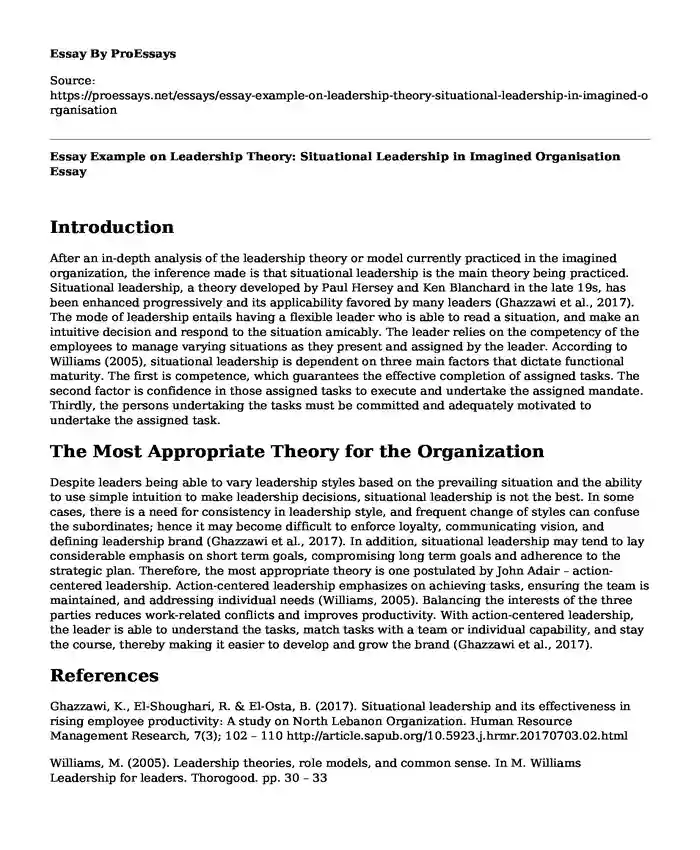Introduction
After an in-depth analysis of the leadership theory or model currently practiced in the imagined organization, the inference made is that situational leadership is the main theory being practiced. Situational leadership, a theory developed by Paul Hersey and Ken Blanchard in the late 19s, has been enhanced progressively and its applicability favored by many leaders (Ghazzawi et al., 2017). The mode of leadership entails having a flexible leader who is able to read a situation, and make an intuitive decision and respond to the situation amicably. The leader relies on the competency of the employees to manage varying situations as they present and assigned by the leader. According to Williams (2005), situational leadership is dependent on three main factors that dictate functional maturity. The first is competence, which guarantees the effective completion of assigned tasks. The second factor is confidence in those assigned tasks to execute and undertake the assigned mandate. Thirdly, the persons undertaking the tasks must be committed and adequately motivated to undertake the assigned task.
The Most Appropriate Theory for the Organization
Despite leaders being able to vary leadership styles based on the prevailing situation and the ability to use simple intuition to make leadership decisions, situational leadership is not the best. In some cases, there is a need for consistency in leadership style, and frequent change of styles can confuse the subordinates; hence it may become difficult to enforce loyalty, communicating vision, and defining leadership brand (Ghazzawi et al., 2017). In addition, situational leadership may tend to lay considerable emphasis on short term goals, compromising long term goals and adherence to the strategic plan. Therefore, the most appropriate theory is one postulated by John Adair – action-centered leadership. Action-centered leadership emphasizes on achieving tasks, ensuring the team is maintained, and addressing individual needs (Williams, 2005). Balancing the interests of the three parties reduces work-related conflicts and improves productivity. With action-centered leadership, the leader is able to understand the tasks, match tasks with a team or individual capability, and stay the course, thereby making it easier to develop and grow the brand (Ghazzawi et al., 2017).
References
Ghazzawi, K., El-Shoughari, R. & El-Osta, B. (2017). Situational leadership and its effectiveness in rising employee productivity: A study on North Lebanon Organization. Human Resource Management Research, 7(3); 102 – 110 http://article.sapub.org/10.5923.j.hrmr.20170703.02.html
Williams, M. (2005). Leadership theories, role models, and common sense. In M. Williams Leadership for leaders. Thorogood. pp. 30 – 33
Cite this page
Essay Example on Leadership Theory: Situational Leadership in Imagined Organisation. (2023, Sep 10). Retrieved from https://proessays.net/essays/essay-example-on-leadership-theory-situational-leadership-in-imagined-organisation
If you are the original author of this essay and no longer wish to have it published on the ProEssays website, please click below to request its removal:
- Education Research Paper Example on Leadership in Learning Institutions
- Paper Example on Effective Online Business Strategies in the Area of E-Commerce
- Incorporating the Evidence in Data-Driven Decision Making Essay
- Planning and Resource Management Paper Example
- Paving a Way for Addicted Teens Through Effective Leadership - Essay Sample
- Case Study Analysis Example: Treatment & Task Groups
- Free Essay Sample on Nike: Maximizing Athletes' Potential & Shareholder Value







